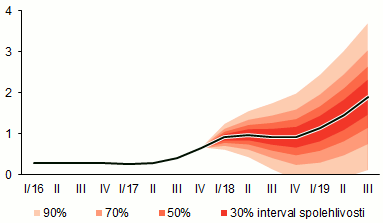A fundamental theme of this year is the ever increasing rates on MORTGAGE LOANS. For most of us, this is a financial topic of the utmost importance. It has been all over the news lately that interest rates in recent months have kept rising. The rates are currently above 2% and they are expected to climb higher. Why?
Brno, Mar 17 (Partners) – The increasing rates are a result of Czech National Bank (CNB) interventions, Prague Interbank Offered Rate (PRIBOR) interventions and many other events. To understand how rates change we must know how the different variables affect them.
PRIBOR is the rate at which banks lend to each other. Then a bank margin is added to this rate to determine the rate that consumers will receive. A bank margin is generally about 1.5%.
In other words, the mortgage loan rate for consumers is: PRIBOR + “bank margin”. This is a simplified description of the state of affairs, but sufficient for our needs.
When the rates on mortgage loans were at a historic low in the second half of 2016, the PRIBOR fluctuated between 0.1% to 0.2%. However, today the PRIBOR is about 0.5%. So far, these are the facts that we know.
But what will the PRIBOR do next? According to the CNB forecast (see the figure below, which includes a reference to the source) the PRIBOR will remain at less than 1% this year, and in 2019 rise to around 2%. That means the interest rate on mortgage loans is forecast to increase to 3% – 3.5%, and in the worst case, up to 4% (source: Czech National Bank, ČNB).
Why are interest rates increasing and why is the PRIBOR not the same as in 2016? Partners’ analyst Martin Mašát very briefly and simply explains what is causing the shift in the rates and further expands on this topic. (The link to his interview is below.)
Simply put, during the time the PRIBOR was at 0.1% -0.2%, it was convenient for banks to lend money to clients for 1.6% because government bonds were negative. However, now that the PRIBOR is 1% (and government bonds are already in positive numbers), banks do not need to “risk” as much and are able to lend to their clients at lower rates (source: Finance.idnes.cz).
Now that we know what is happening and what will happen, it is clear that the prospects are not entirely rosy. You may be asking yourself, “What shall we do? Sell our apartments or houses and buy tents or move to the Ústí region?” That is a possibility, but there are simpler solutions, namely FORWARD REFINANCING and RENEWAL RATE :-).
Although they are two different terms, they actually represent very similar ideas. The main difference is that in the first variant, forward refinancing, clients change their bank when refinancing and in the second variant, renewal rate, the bank remains the same, but with a new interest rate.
All banks offer the possibility to “reserve” the rate they had one year before the fixed rate period ends with the current mortgage loan; some banks are even able to do this 2 years in advance. How does reserving rates work in practice? For a better understanding I have provided two examples:
1) The fixed rate period of your mortgage ends in about 1 year. In this case we will contact your current bank to know their new interest rate offer for the next period. When the bank offers us a new rate, we will play a little coy and bargain;-) (NOTE: Usually the bank never offers the best they can do on the first inquiry.) Once they have offered a new rate and we agree that the new rate is acceptable, we will sign the addendum and be finished.
2) The fixed rate period of your mortgage ends in 1-2 years. If your current mortgage is fixed through one of the few banks that are able to reserve a rate up to 2 years in advance, we will still apply the same procedure as above. If your bank can not adhere to the procedure above then we will apply for a new loan with another bank that meets the conditions required for the procedure above while enabling the loan to be drawn up for up to 2 years (i.e. at the end of the fixed rate term on the current mortgage loan).
The process for a mortgage that is only fixed for another 1-2 years may seem a little more complicated, but if handled properly it can save you a lot of money. Timing is very important – it is best to deal with the details now and not leave your mortgage rate to its fate.
To illustrate, an increase in an interest rate by 1% (eg. from 1.99% to 2.99%) for a loan in the amount of CZK 1,500,000 with a maturity of 25 years means that the monthly installment would increase by 775 CZK. Therefore, assuming the fixed rate for 5 years, the total difference would be CZK 46 500 CZK. That is at least one very nice holiday! 🙂
If you have any questions, feel free to contact me anytime. I would also like to invite you to the Housing and Real Estate seminar organized by Brno Expat Centre (March 22, 2018), where I will be talking about mortgages. Click here to learn more about the seminar and register for the event.
Monika Pimková, Senior Financial Advisor at Partners Financial Services
In the world of finances, my mission is to help my clients understand this world, get the best gains out of it and to become their reliable advisor for life. I take pride in leading them to realise their financial goals (their dreams), get them prepared for the situations life can bring and, no matter what comes upon them, to manage and retain their own financial freedom. Questions? Need help? Contact me at monika.pimkova@partners.cz.
This is a sponsored content.









